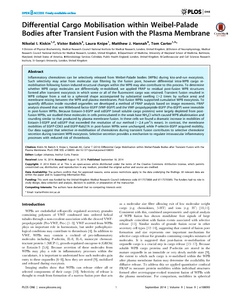Kiskin, NI; Babich, V; Knipe, L; Hannah, MJ; Carter, T
(2014)
Differential cargo mobilisation within Weibel-Palade bodies after transient fusion with the plasma membrane.
PLoS One, 9 (9).
ISSN 1932-6203
https://doi.org/10.1371/journal.pone.0108093
SGUL Authors: Carter, Thomas David
![[img]](https://openaccess.sgul.ac.uk/107287/1.hassmallThumbnailVersion/Differential_cargo_mobilisation_Weibel_Palade.pdf)  Preview |
|
["document_typename_application/pdf; charset=binary" not defined]
Published Version
Download (6MB)
| Preview
|
Abstract
Inflammatory chemokines can be selectively released from Weibel-Palade bodies (WPBs) during kiss-and-run exocytosis. Such selectivity may arise from molecular size filtering by the fusion pore, however differential intra-WPB cargo re-mobilisation following fusion-induced structural changes within the WPB may also contribute to this process. To determine whether WPB cargo molecules are differentially re-mobilised, we applied FRAP to residual post-fusion WPB structures formed after transient exocytosis in which some or all of the fluorescent cargo was retained. Transient fusion resulted in WPB collapse from a rod to a spheroid shape accompanied by substantial swelling (>2 times by surface area) and membrane mixing between the WPB and plasma membranes. Post-fusion WPBs supported cumulative WPB exocytosis. To quantify diffusion inside rounded organelles we developed a method of FRAP analysis based on image moments. FRAP analysis showed that von Willebrand factor-EGFP (VWF-EGFP) and the VWF-propolypeptide-EGFP (Pro-EGFP) were immobile in post-fusion WPBs. Because Eotaxin-3-EGFP and ssEGFP (small soluble cargo proteins) were largely depleted from post-fusion WPBs, we studied these molecules in cells preincubated in the weak base NH4Cl which caused WPB alkalinisation and rounding similar to that produced by plasma membrane fusion. In these cells we found a dramatic increase in mobilities of Eotaxin-3-EGFP and ssEGFP that exceeded the resolution of our method (∼ 2.4 µm2/s mean). In contrast, the membrane mobilities of EGFP-CD63 and EGFP-Rab27A in post-fusion WPBs were unchanged, while P-selectin-EGFP acquired mobility. Our data suggest that selective re-mobilisation of chemokines during transient fusion contributes to selective chemokine secretion during transient WPB exocytosis. Selective secretion provides a mechanism to regulate intravascular inflammatory processes with reduced risk of thrombosis.
Statistics
Item downloaded times since 07 Jan 2015.
Actions (login required)
 |
Edit Item |



